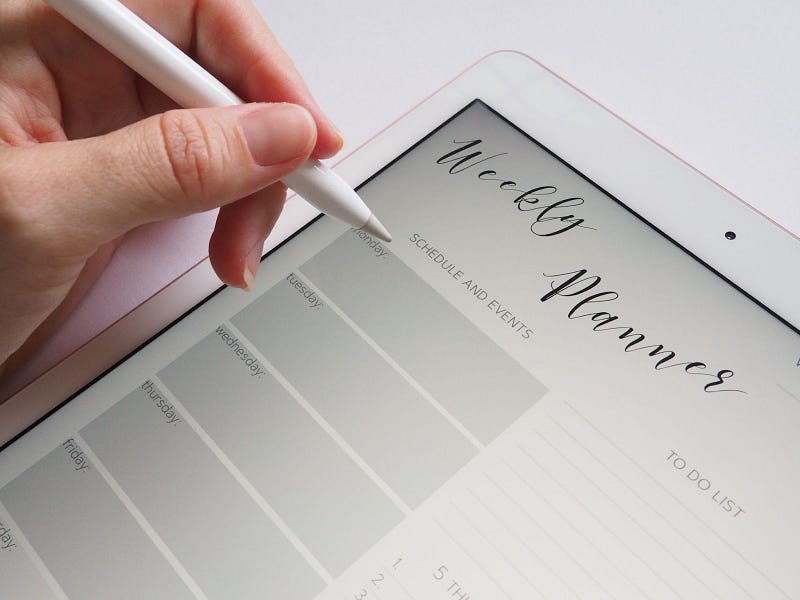One of the biggest challenges we all face in our everyday lives is striking a healthy and productive work-life balance. If you are fortunate enough to be granted some flexibility in your work hours, you have the opportunity to create a work schedule that is both productive and conducive to your personal life.
So, how exactly can you create the perfect work schedule for your specific needs?
In this article, we will outline some tips for creating a productive work schedule that works for you — not only maximizing your time during work hours but also accommodating the other important aspects of your life. Keep reading for some helpful advice on how to get the most out of your work schedule!

Creating a productive work schedule
Let’s discuss the concept of making your schedule as productive as it can possibly be. There are a few things you should consider when trying to boost your productivity, such as your work style, your preferred time of day to work, how many hours you need to complete each week, and the type of work you do.
Work style
Different people work best in different ways, and the way you work best is referred to as your ‘work style.’ Some of the most common work styles are:
1) ‘The Morning Person’ — This person likes to start their day early and gets most of their work done before lunch. They are usually done with their day’s work by early afternoon, leaving the rest of the day free.
2) ‘The Night Owl’ — This person likes to do their work in the evening and usually stays up late working. They usually don’t start their day until noon or later, and they may take work home with them to do at night.
3) ‘The Balanced Person’ — This person likes to have a mix of morning and evening work hours. They usually start their day early, but then take a break in the afternoon to do some personal errands or relax. They then work evening hours to catch up on any work they may have missed during the day.
4) ‘The Chaotic Person’ — This person does not have a specific time of day that they work best, and they often switch between working morning, afternoon, and evening hours. They may have a lot of work to do, but they also have a lot of free time where they don’t do any work at all.

When it comes to productivity, sometimes the key to success is figuring out what your personal work style is. To find out how you work best, ask yourself these questions:
- How do you feel when you work? For example, do you feel energized or exhausted?
- When are you most productive?
- Do you like to work alone or with others? Some people prefer working alone in a quiet environment, while others thrive in a more collaborative environment with coworkers.
- How do you like to structure your day? Do you like to have a plan and stick to it, or are you more of a sporadic and flexible worker?
Once you know how and when you work best, you can then begin implementing this into your work schedule.
The morning person
If you are a morning person, a productive day for you might look like this:
Wake up at 6 am and spend 30 minutes working out. Have breakfast and start work at 8 am. Take a break for lunch at 12 pm, then continue work until 4 p.m. Finish up any remaining work tasks by 5 pm, then enjoy the evening.
This schedule allows for a good amount of work time, as well as some time for breakfast, lunch, and dinner. The morning person’s work schedule also leaves plenty of time for relaxation in the evening.
The night owl
If you are someone who works best at night time, however, a productive day for you might look a bit more like this:
Wake up at 10 am and enjoy breakfast and some leisure time, then start working at 12 pm and continue until 6 pm. Take a break for dinner and more leisure time, then work again from 8 pm to 2 am.
This schedule allows you plenty of time for rest and relaxation, while still giving you enough time to get your work done. It also ensures that you will have plenty of energy for working at night.
The balanced person
If you like to do a bit of work in the morning and then a bit later on in the day, a productive workday for you might look like this:
Get up at 6 am and do some work until 8 am. Then take a break and do something non-work-related until noon. Work again from 1 pm to 4 pm, then take another break before working from 6 pm to 10 pm.
If you’re more of a morning person than an afternoon person, you could swap the times around so that you work from 8 am to noon, take a break, then work from 1 pm to 4 pm, and take another break before working from 6 pm to 10 pm.
The chaotic person
The chaotic worker doesn’t have a set routine or preference for when they work best. If this is the case for you, a productive day might look like this:
Wake up and immediately start working on the most important task of the day. Take a break after an hour to get some fresh air or do something else unrelated to work. Work on a different task for two hours, then take another break. Work on a third task for three hours. Finish up any remaining tasks and call it a day.
You will notice that this schedule does not have any set times, but it allows you to get the important things done while still giving yourself some breaks throughout the day.

No matter when you work, it’s important that you allow for some time each day for yourself — whether that’s going for a walk, reading a book, or spending time with friends and family.
Putting your work schedule in writing
Once you have figured out what your personal work style looks like, fitting in with that work style will allow you to be more time-efficient and get all of your tasks done on time.
Now, your next task is to actually set up your schedule. This may involve the use of an app or calendar. The most important part of this step is to be realistic with yourself, as it will do no good to set unrealistic goals and then become discouraged when they are not met.
Planning the work schedule
To create your schedule, you will need the following:
- Your personal work style
- A list of all the tasks you need to do on a daily, weekly, or monthly basis
- A realistic timeline for completing each task
The following is an example of how to create a schedule using these three items:
Daily Tasks:
- Check email
- Return phone calls
- Work on project A
Weekly Tasks:
- Meet with client X
- Work on project B
Monthly Tasks:
- Update company website
- Review budget
Now that you have your list of tasks, you need to figure out how long each task will take you to complete. For example, checking email may only take 5 minutes, but meeting with a client may take an hour.
Creating the work schedule
Once you have estimated the time each task will take, it’s time to create your schedule. You can make this easy by downloading a work schedule app that gives you space to plan out your entire week, set recurring tasks, and schedule breaks.
Another way to do this is by using a time management tool like Google Calendar or a paper planner. If you’re using a paper planner, block out the times of day that you will be working on each task. If you’re using Google Calendar, create separate calendars for each task and then drag and drop the tasks into the time slots that they will be completed.
No matter which way you choose to create your schedule, make sure that you are realistic about how much time each task will take. It’s important to leave some “wiggle room” in your schedule in case something comes up.

Productivity tips
If you find that you are having trouble getting started on your work, try breaking it down into smaller tasks that can be completed one at a time. This will help to avoid feeling overwhelmed and stressed.
It is also important to take breaks throughout the day, as this allows your mind to refresh and prevents you from becoming burnt out. A good way to keep track of your breaks is to use a timer or an app that reminds you when it is time to take a break.
Time tracking can also help you to stay motivated and productive, as it shows how long you spend working on tasks and gives you accountability. One of the most effective time tracking apps available is Day.io, as it allows you to track your hours and integrates with other work-related apps.
Bottom line
In today’s work climate, it is becoming more commonplace to work remotely and set your own hours. This is where setting a schedule that fits your lifestyle can really come in handy. By using the above tips, you can create a work schedule that allows you to work when you are at peak concentration and effectiveness.
Remember that the schedule you make now is never set in stone. You can keep tweaking it and making changes until your schedule works for you!

